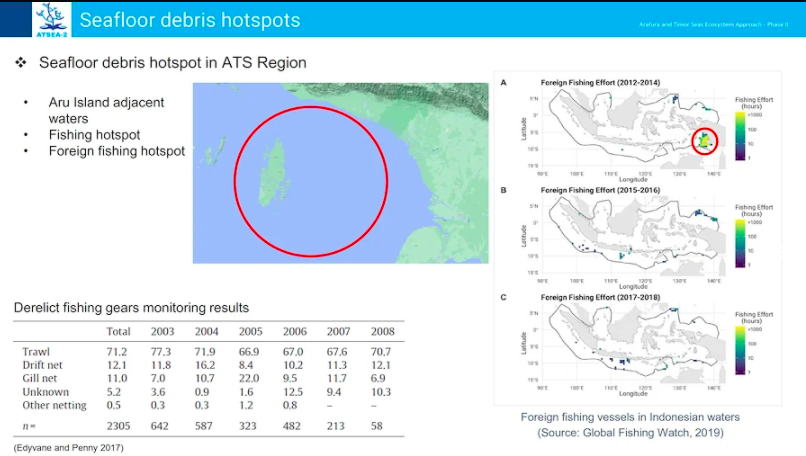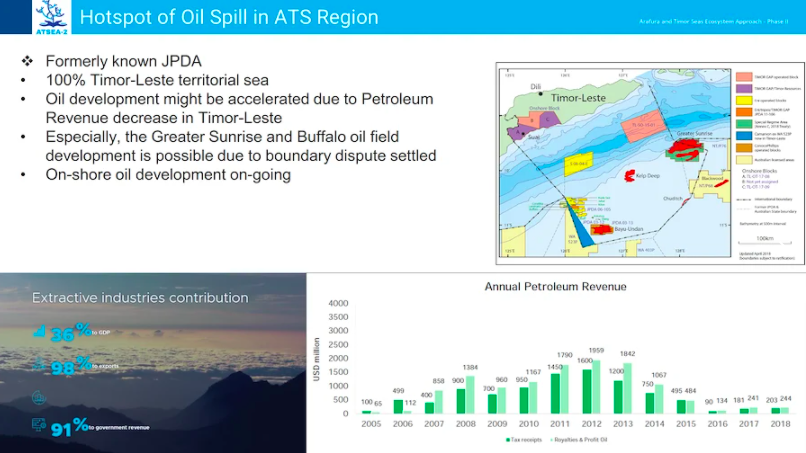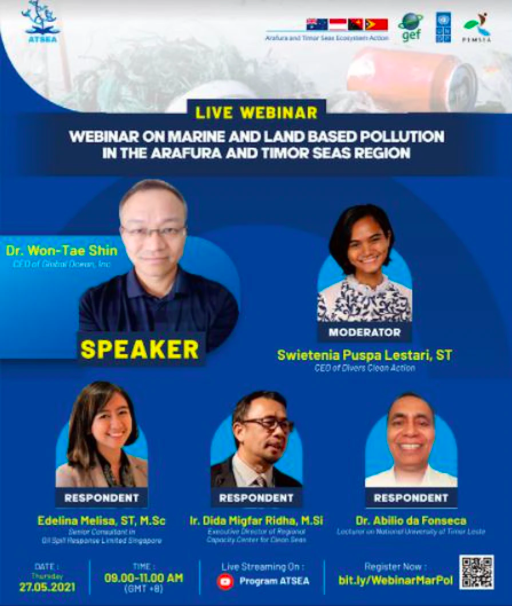New study pinpoints marine pollution hotspots in the ATS region
Tuesday, 12 October 2021

This article was originally published on IW:Learn on June 6, 2021.
GEF IW:LEARN World Oceans Day 2021 Special Issue
The Arafura and Timor Seas (ATS) region is not only extremely rich in living marine resources, but also oil and gas reserves. According to a recent study by Dr. Won-Tae Shin, CEO of Global Ocean, Inc. in collaboration with the ATSEA-2 programme, the southern coast of Timor Island is especially vulnerable to oil spills occurring in the Timor Sea, specifically around the Rote Ndao District. The results of preliminary modelling also identified waters surrounding Aru Island and the south coast of Timor-Leste as hotspots for seafloor debris such as derelict fishing gear.
His assessment also showed that Rote Ndao District in Indonesia and the south coast of Timor-Leste have been pinpointed as the areas most vulnerable to oil spills and hotspots for discarded fishing equipment. Recent analyses suggest that the Montara spill of 2009 remains fresh in the minds of local residents, with impacts still being felt in the region. Furthermore, as oil and gas exploration expands and shipping lanes in the area become more congested, the risk of similar incidents continues to grow.

Seafloor debris hotspot in the ATS Region. Image credit: ATSEA-2, 2021
The study to identify pollution hotspots at the regional and national levels in ATS had been concluded. Therefore, on 27 May 2021, ATSEA-2 held a webinar entitled Marine and Land-Based Pollution in the Arafura and Timor Seas Region, in order to update key stakeholders in ATS countries on the results of marine and land-based pollution assessments.
In response to the latest results, ATS countries have been presented with recommendations from a group of experts. These include Dr. Abilio da Fonseca, lecturer at the National University of Timor-Leste; Ir. Dida Migfar Ridha, M.Si, Executive Director of the Regional Capacity Center for Clean Seas; and Edelina Melisa, ST, M.Sc, Senior Consultant at Oil Spill Response Limited (OSRL) Singapore. All agree with Dr. Shin’s recommendations for the ATS nations to ratify the International Convention on Oil Pollution Preparedness, Response and Co-operation (OPRC) 1990 agreement, develop a regional platform for oil spill responses, and establish a monitoring programme on marine debris.

Hotspots for oil spills in the ATS Region
Reflecting on the study conducted in Timor-Leste, Dr. da Fonseca showed how illegal, unreported, and unregulated fishing and climate change could contribute to marine pollution and how other countries affect Timor-Leste’s water quality. As marine pollution is not a standalone issue, he insisted on the importance of regional cooperation and collaboration to tackle the issue.
Mr. Ridha and Ms. Melisa also echoed Dr. da Fonseca. They underscored the need to collaborate, especially with already existing regional platforms, such as Regional Capacity Center for Clean Seas (RC3S) and Global Initiative SouthEast Asia (GI SEA), and international initiatives like Sustainable Development Goals (SDGs) to avoid duplication of efforts and reinventing the wheel.
Lastly, Ms. Melisa highlighted that the success of regional initiatives will rely on national capacities. Thus, capacity building and information and/or best practices exchanges are crucial, especially for national stakeholders.

Poster for the webinar conducted by the ATSEA-2 Programme
The Transboundary Diagnostic Analysis (TDA) for the ATS region highlighted the growing threat imposed by emerging issues related to marine debris and waste from fishing and shipping vessels, as well as marine-based pollution from oil and gas activities. The ATSEA-2 Programme covers the five priority transboundary environmental problems identified by the TDA: (i) unsustainable fisheries and decline and loss of living coastal and marine resources; (ii) modification, degradation and loss of coastal and marine habitats; (iii) marine and land-based pollution; (iv) decline and loss of threatened and migratory species; and (v) mitigating the impacts of climate change on the ATS by removing key barriers to sustainable management of the region.
The ATS region’s flourishing ocean ecosystem is currently under threat. In order to minimise the impacts of marine and land-based pollution, regional governments must collectively establish plans for guided intervention. The development of a cohesive strategy is urgently needed.
About the ATSEA-2 Programme
ATSEA-2 is the second phase of the Arafura & Timor Seas Ecosystem Action (ATSEA) programme; a regional partnership involving the governments of Indonesia, Timor-Leste and Papua New Guinea, with the support of the Australian Government. Its objective is to collectively manage high marine and fisheries resources in the Arafura and Timor Seas (ATS) region. Since its inception in 2019, the programme has been working to promote sustainable development in the ATS region and improve the quality of life of its inhabitants through a combination of restoration, conservation and sustainable management of marine-coastal ecosystems. The ATS is an area of high productivity in the region and ATSEA-2 is committed to safeguarding the livelihoods and prosperity of coastal people, particularly in its transboundary areas, through the implementation of sustainable integrated concepts. ATSEA-2 is a Global Environment Facility (GEF)-funded programme, managed and executed under the United Nations Development Programme (UNDP). Partnerships in Environmental Management for the Seas of East Asia (PEMSEA) Resource Facility (PRF) is an implementing partner.
For more information on the ATSEA-2 programme, please contact the Regional Project Manager, Handoko Adi Susanto (hasusanto@pemsea.org), visit the project page on iwlearn.net or the project website.



